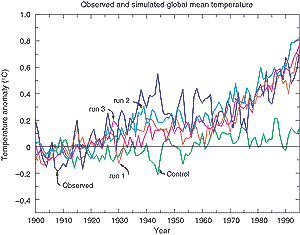|
|
 |
 |
 |
 |
 |
REPORTS - ASSESSMENT REPORTS |
 |
 |
|
 |
|
 |
|
|
WG I The Scientific Basis - Technical Summary
 |
 |
Climate Change 2001: The Scientific Basis |
|
|
|
D.4 Overall Assessment of Abilities
Coupled models have evolved and improved significantly since the SAR. In general,
they provide credible simulations of climate, at least down to sub-continental
scales and over temporal scales from seasonal to decadal. Coupled models, as a
class, are considered to be suitable tools to provide useful projections of future
climates. These models cannot yet simulate all aspects of climate (e.g., they
still cannot account fully for the observed trend in the surface-troposphere temperature
differences since 1979). Clouds and humidity also remain sources of significant
uncertainty, but there have been incremental improvements in simulations of these
quantities. No single model can be considered "best", and it is important
to utilise results from a range of carefully evaluated coupled models to explore
effects of different formulations. The rationale for increased confidence in models
arises from model performance in the following areas.
Flux adjustment
The overall confidence in model projections is increased by the improved performance
of several models that do not use flux adjustment. These models now maintain stable,
multi-century simulations of surface climate that are considered to be of sufficient
quality to allow their use for climate change projections. The changes whereby
many models can now run without flux adjustment have come from improvements in
both the atmospheric and oceanic components. In the model atmosphere, improvements
in convection, the boundary layer, clouds, and surface latent heat fluxes are
most notable. In the model ocean, the improvements are in resolution, boundary
layer mixing, and in the representation of eddies. The results from climate change
studies with flux adjusted and non-flux adjusted models are broadly in agreement;
nonetheless, the development of stable non-flux adjusted models increases confidence
in their ability to simulate future climates.
Climate of the 20th century

Figure 13: Observed and modelled global annual mean temperature anomalies
(°C) relative to the average of the observations over the period 1900
to 1930. The control and three independent simulations with the same greenhouse
gas plus aerosol forcing and slightly different initial conditions are shown
from an AOGCM. The three greenhouse gas plus aerosol simulations are labeled
'run 1', 'run 2', and 'run 3' respectively. [Based on Figure
8.15] |
Confidence in the ability of models to project future climates is increased
by the ability of several models to reproduce warming trends in the 20th century
surface air temperature when driven by increased greenhouse gases and sulphate
aerosols. This is illustrated in Figure 13. However,
only idealized scenarios of sulphate aerosols have been used and contributions
from some additional processes and forcings may not have been included in the
models. Some modelling studies suggest that inclusion of additional forcings like
solar variability and volcanic aerosols may improve some aspects of the simulated
climate variability of the 20th century.
Extreme events
Analysis of and confidence in extreme events simulated within climate models
are still emerging, particularly for storm tracks and storm frequency. "Tropical-cyclone-like"
vortices are being simulated in climate models, although enough uncertainty remains
over their interpretation to warrant caution in projections of tropical cyclone
changes. However, in general, the analysis of extreme events in both observations
(see Section B.6) and coupled models is underdeveloped.
Interannual variability
The performance of coupled models in simulating ENSO has improved; however,
its variability is displaced westward and its strength is generally underestimated.
When suitably initialised with surface wind and sub-surface ocean data, some
coupled models have had a degree of success in predicting ENSO events.
Model intercomparisons
The growth in systematic intercomparisons of models provides the core evidence
for the growing capabilities of climate models. For example, the Coupled Model
Intercomparison Project (CMIP) is enabling a more comprehensive and systematic
evaluation and intercomparison of coupled models run in a standardised configuration
and responding to standardised forcing. Some degree of quantification of improvements
in coupled model performance has now been demonstrated. The Palaeoclimate Model
Intercomparison Project (PMIP) provides intercomparisons of models for the mid-Holocene
(6,000 years before present) and for the Last Glacial Maximum (21,000 years before
present). The ability of these models to simulate some aspects of palaeoclimates,
compared to a range of palaeoclimate proxy data, gives confidence in models (at
least the atmospheric component) over a range of difference forcings.
|
|
 |
|
|
 |
|
 |
|
|